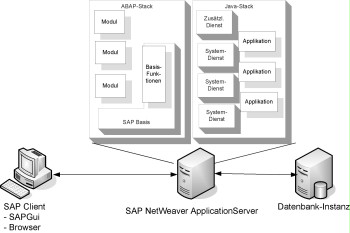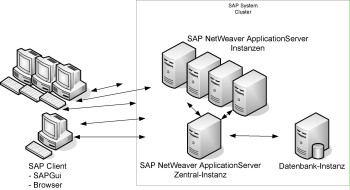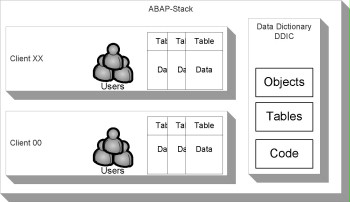S 3.53 Introduction to SAP systems
Initiation responsibility: Head of IT
Implementation responsibility: User, Administrator
Core components of an SAP system installation
A simplified SAP system installation consists of the following core components:
- SAP NetWeaver Application Server
The SAP NetWeaver Application Server runs the SAP applications or modules. - Database instance
The database instance contains the database that stores all data used by the SAP system. - SAP clients
The SAP clients consist of the SAPgui or a normal browser.

Figure: Overview of an SAP system
The SAP NetWeaver Application Server generally consists of two components: the ABAP stack and the Java stack. The actual functions of the applications and modules are executed on this server in the stack corresponding to the programming language used in the application or module.
ABAP stack
The ABAP stack is the traditional execution environment of an SAP system. This applies especially to the system versions generally referred to using the term SAP R/3 since the R/3 components and modules are executed in the ABAP stack.
The ABAP stack consists of the SAP Basis, a collection of (ABAP) programs and functions that implement the basic functionality (e.g. user administration). Furthermore, it is possible to install additional ABAP programs. These programs are placed in application-specific modules (e.g. HCM, FI). The programs of the ABAP stack are started via transactions. However, not every ABAP program is assigned a transaction. More often there are transactions called by programs that allow other programs to be started (e.g. transaction SE38, Start Programs).
Java stack
The Java stack consists of individual system services that implement the system functions of the Java stacks. Furthermore, it is possible to install additional services and applications to extend its functionality. Applications can access the functions available in the various services in this case. The services, functions, and applications of the Java stack are generally accessed using Internet-based protocols (e.g. HTTP).

Figure: ABAP and Java stacks of an SAP system
Instances
To enable an SAP system to handle a large number of users, it is possible to set up an SAP system consisting of several individual instances of the NetWeaver Application Server (which is then referred to as a cluster). These instances then share the user load and form a single SAP system from the point of view of the clients. The load is distributed among the individual servers by internal system mechanisms. One of these instances is called the main instance, which is also referred to as the central instance. Additional instances can then be added to the central instance by installing additional SAP NetWeaver application servers. The individual instances communicate with each other so that the cluster appears to be a single SAP system to the clients.

Figure: SAP instances
Clients and DDIC
The ABAP stack is organised technically into clients. In addition, there is a Data Dictionary (DDIC) containing all the objects the ABAP stack. The most important objects are the tables, the ABAP programs, and any objects used in the ABAP programs. Clients represent a closed set of users, functions, and tables. It is generally impossible for a client to access another client, with the exception of the client-independent objects (e.g. tables), which can be accessed by any client. Changes to such objects will then affect all other clients.

Figure: Clients of an SAP system
User
In terms of users, the ABAP stack divides the users into two types of users: those with their own user master record and those without their own user master record. Since users with their own user master record are administered using transaction SU01, these users are often also referred to as SU01 users. In contrast, the Internet users are not assigned their own user master record. Internet users were previously administered using transaction SU05, but this procedure is not recommended any more by SAP. Instead, it is recommended to create Internet users using transaction SU01 as well and link them to a single reference user that can then be used by the various Internet users. The following user types can be specified for SU01 users depending on how they use the system. Each user type comes with its own limitations:
- Dialog user: These users are allowed to log on interactively to the SAP system (dialog logon).
- System user: These users cannot log on to the SAP system in a dialog box. These users can be used for background processing (batch jobs).
- Communication user: These users are allowed to use the technical communication capabilities (e.g. remote function calls or RFCs). These users cannot log on to the SAP system in a dialog box.
- Service user: This user is considered a technical user. This user can log on in a dialog box.
- Reference user: The user is used as reference for Internet users. The user cannot log on to the system.
SAP source of information
SAP systems are complex and consist of numerous components. To provide operators of SAP systems with information and recommendations on the SAP products, SAP uses the SAP Notes. These notes are identified by a unique number and can be called from the SAP Service Marketplace (see S 2.346 Use of the SAP documentation).

